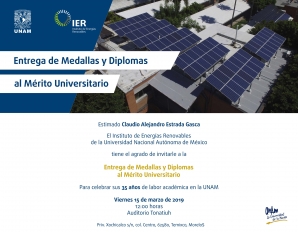Mostrando artículos por etiqueta: Applied Thermal Engineering
Geometric optimization of a solar cubic-cavity multi-tubular thermochemical reactor using a Monte Carlo-finite element radiative transfer model
Valades-Pelayo P.J., Romero-Paredes H., Arancibia-Bulnes C.A., Villafán-Vidales H.I.
Abstract
In the present study, the optimization of a multi-tubular solar thermochemical cavity reactor is carried out. The reactor consists of a cubic cavity made of woven graphite, housing nine 2.54 cm diameter tungsten tubes. A heat transfer model is developed and implemented considering high-temperature radiative transfer at steady state. The temperature distribution on the receiver tubes is determined by using a hybrid Monte Carlo-finite volume approach. The optimization aims at maximizing average tube temperature by varying tube locations. Optimal tube distributions are explored by using a custom-made stochastic, multi-parameter, global optimization algorithm. A considerable increase in average temperature as well as improvement on temperature uniformity is found in the optimized tube arrays. Patterns among the different optimal distributions are found, and general features are discussed
Theoretical and experimental study of natural convection with surface thermal radiation in a side open cavity
M. Montiel-González, J.F. Hinojosa, H.I. Villafán-Vidales, A. Bautista-Orozco, C.A. Estrada.
Abstract
In this work a theoretical and experimental study of heat transfer by natural convection and thermal radiation on a solar open cubic cavity-type receiver is presented. The theoretical study consists on solving the laminar natural convection and the surface thermal radiation on a square open cavity at one end. The overall continuity, momentum, and energy equations in primitive variables are solved numerically by using the finite-volume method and the SIMPLEC algorithm. The thermophysical properties of the fluid are considered, for the first case, as temperature dependent in all the governing equations, and for the second case, constant, except for the density at the buoyancy term (Boussinesq approximation), with the purpose of comparing the results of both theoretical models with experimentally obtained results. Numerical calculations are conducted for Rayleigh number (Ra) values in the range of 104–106. The temperature difference between the hot wall and the bulk fluid (ΔT) is varied between 10 and 400 K, and is represented as a dimensionless temperature difference (φ) for the purpose of generalization of the trends observed. Experimental results include air temperature measurements inside the receiver. These results are compared with theoretically obtained air temperatures, and the average deviation between both results is around 3.0%, when using the model with variable thermophysical properties, and is around 5.4% when using the Boussinesq approximation.
Correction of the concentrated sunlight spot´s drift of the IER-UNAM´s solar furnace
R. Pérez-Enciso, E. Brito-Bazan, C.A. Pérez-Rábago, C.A. Arancibia-Bulnes, D. Riveros-Rosas, C.A. Estrada.
Abstract
This paper discusses the methods implemented for the solution of the drift and backlash problems in the heliostat of the High Radiative Flux Solar Furnace recently built at the Renewable Energy Institute (former Center for Energy Research) of the National University of Mexico (IER-UNAM), located at the geographical coordinates 18°50′24″ North latitude and 99°15′00″ West longitude. To solve the observed drift, several algorithms were analyzed for the calculation of the solar vector, and a closed loop through an electronic device (peephole) was implemented which makes corrections to the position of the heliostat. Using the peephole, drift heliostat decreased significantly; 70% in the horizontal direction and 63% in the vertical direction relative to the no use of peephole. The backlash was corrected by means of unbalancing the heliostat.
Correction of the concentrated sunlight spot´s drift of the IER-UNAM´s solar furnace

